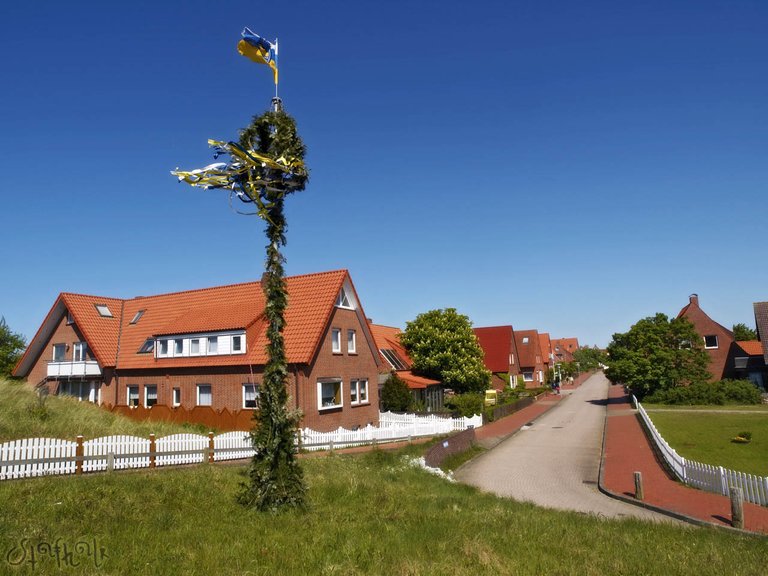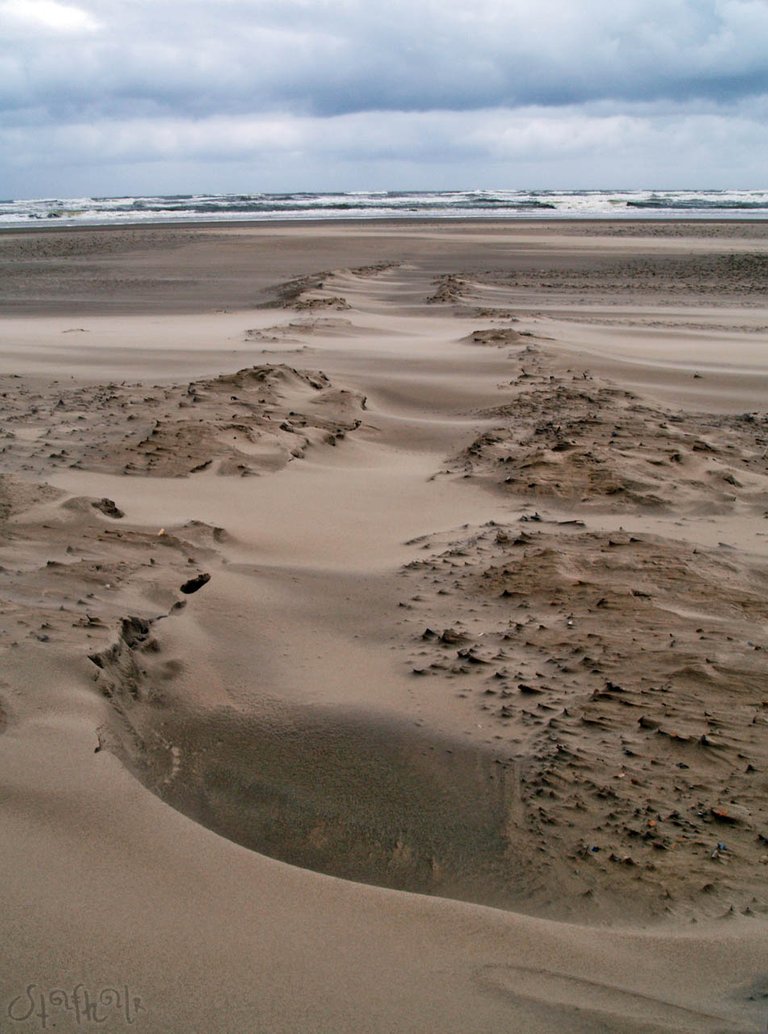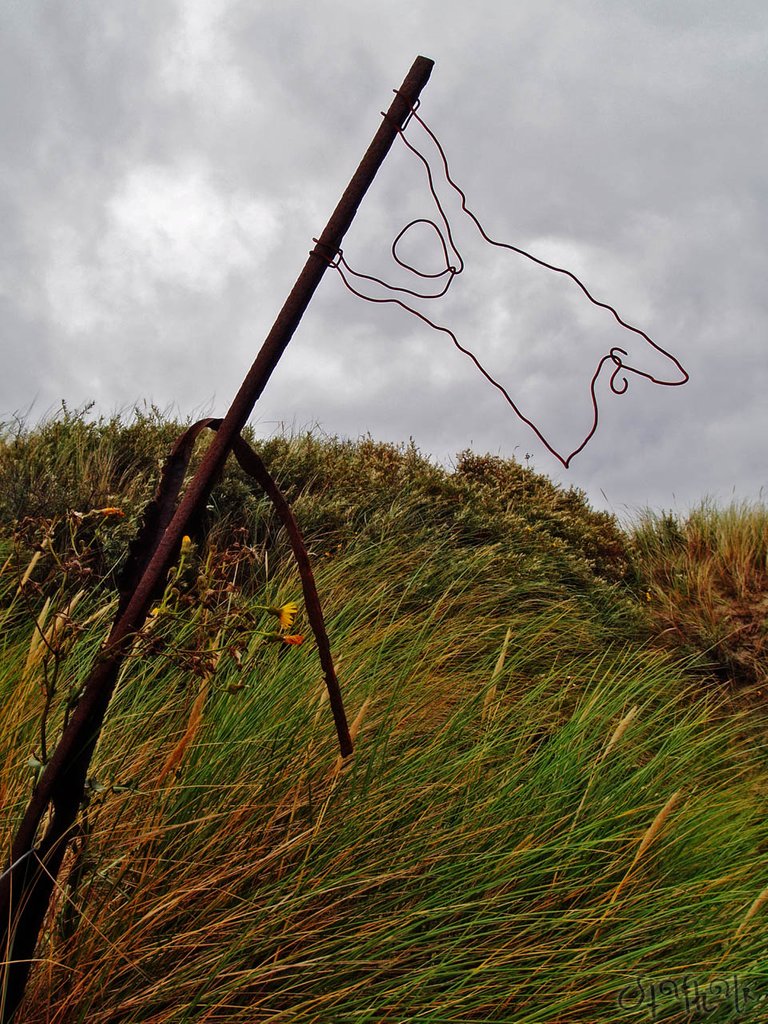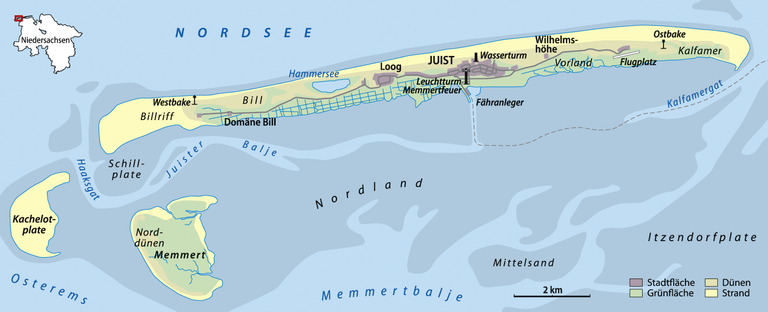
| PL | ENG |
|---|---|
| Juist jest jedną z wysp tworzących archipelag Wysp Wschodniofryzyjskich nad Morzem Północnym w Niemczech. Wyspa ma 17 kilometrów długości i od 500 metrów do 1 kilometra szerokości (mają na to duży wpływ również pływy morskie). | Juist is one of the islands of the East Frisian Islands chain in the North Sea in Germany. The island is 17 kilometers long and 500 meters to 1 kilometer wide (influenced by sea tides). |


| PL | ENG |
|---|---|
| Wyspa jest kurortem turystycznym – znaczna większość mieszkańców utrzymuje się z turystyki. Znajdują się tam liczne hotele, pensjonaty, restauracje i inne lokale. | The island is a tourist resort - the vast majority of its inhabitants make a living from tourism. There are numerous hotels, guesthouses, restaurants and other establishments. |




| PL | ENG |
|---|---|
| Charakterystyczne i cieszące się powodzeniem są wyjątkowo szerokie, piaszczyste plaże na Juist. Na większości obszarów występuje roślinność wydmowa, zwłaszcza od strony północnej. Istnieją także obszary podmokłych łąk od południowej strony. Zachodni skraj wyspy to obszary zalewowe, mielizna, obszar bytowania wielu gatunków ptaków – z tylko częściowym dostępem dla turystów. Z kolei na wschodnim krańcu wyspy znajduje się rezerwat przyrody, do którego wstęp możliwy jest tylko od listopada do marca, wyłącznie z przewodnikiem. | Distinctive and popular are the exceptionally wide sandy beaches of Juist. Dune vegetation occurs in most areas, especially on the north side. There are also areas of wet meadows on the south side. The western edge of the island is a floodplain, shoal, habitat for many species of birds - with only partial access for tourists. On the eastern end of the island there is a nature reserve, which can only be entered from November to March, only with a guide. |








| PL | ENG |
|---|---|
| W środkowo-zachodniej części wyspy znajduje się jezioro Hamersee, które powstało w wyniku rozerwania wyspy na dwie części po sztormach w roku 1651, a następnie pracy mieszkańców mającej na celu ponowne połączenie rozdzielonych części. Wody jeziora początkowo były słone, z czasem jednak zmieniły się w słodkie. W rejonie Hamersee znajduje się najbardziej podobny do lasu fragment szaty roślinnej wyspy. | In the central-western part of the island is Lake Hamersee, which appeared as a result of the island being torn in two after the storms of 1651, and then the work of the inhabitants to reconnect the separated parts. The waters of the lake were initially salty, but over time they turned into sweet. The most forest-like fragment of the island's vegetation is located near the Hamersee. |




| PL | ENG |
|---|---|
| Na wyspę można dostać się promem lub niewielkim samolotem. Na wyspie prawie nie ma ruchu samochodowego, poza kilkoma pojazdami pozostającymi w dyspozycji służb. Można odbyć jednak przejażdżkę wozem konnym albo rowerem, który jest wręcz niezbędny, jeśli planuje się tam dłuższy pobyt. | The island can be reached by ferry or small plane. There is almost no car traffic on the island, apart from a few vehicles at the disposal of the services. However, you can take a ride in a horse-drawn cart or a bicycle, which is absolutely necessary if you plan to stay there for a longer time. |





| PL | ENG |
|---|---|
| Znaleziska archeologiczne sugerują, że wyspa była zamieszkana od średniowiecza. Pierwsze wzmianki o niej pochodzą z roku 1398. W roku 1530 na wyspie znajdowały się 23 domy. W XVI i XVII wieku była uszkadzana przez sztormy, aż doszło do rozdzielenia jej na dwie części na dystansie 2 kilometrów. Powódź spowodowała także uszkodzenie fundamentów tutejszego kościoła, co doprowadziło do jego zawalenia się w roku 1662. Nowy zbudowano 700 metrów dalej na południowy wschód. Z racji oddziaływania morza, wyspa cały czas, stopniowo przesuwała się na południe i mieszkańcy musieli przenosić swoje domy. Powódź w 1715 roku zniszczyła drugi kościół. Na większej – wschodniej wyspie powstały dwie wioski: Billdorf w zachodniej i Loogdorf w jej wschodniej części. W 1717 roku miała miejsce kolejna powódź, w wyniku której utonęło 28 osób. W 1779 roku odbudowano kościół po raz piąty (i póki co ostatni). W 1807 roku wyspa przeszła pod panowanie Królestwa Holandii, a na wyspie pojawiły się holenderskie wojska okupacyjne (z francuskimi oficerami). Okupacja skończyła się w 1816 roku. W drugiej połowie XIX wieku zaczęła się rozwijać na wyspie turystyka. Życie kurortu zamarło dopiero podczas II wojny światowej – na wyspie zbudowano umocnienia oraz postawiono znacznych rozmiarów radar. Wyspa była bombardowana przez aliantów. W 1945 na Juist przybyło wielu niemieckich uciekinierów z Pomorza, Prus Wschodnich i Śląska, którzy osiedlili się na wyspie. | Archaeological finds suggest that the island has been inhabited since the Middle Ages. It was first mentioned in 1398. In 1530 there were 23 houses on the island. In the 16th and 17th centuries, it was damaged by storms and split into two parts over a distance of 2 kilometers. The flood also damaged the foundations of the local church, which led to its collapse in 1662. A new one was built 700 meters further south-east. Due to the influence of the sea, the island was gradually moving south all the time and the inhabitants had to move their houses. The flood in 1715 destroyed the second church. On the larger eastern island, two villages were established: Billdorf in the western part and Loogdorf in its eastern part. In 1717, there was another flood, as a result of which 28 people drowned. In 1779, the church was rebuilt for the fifth (and so far the last) time. In 1807, the island came under the rule of the Kingdom of Holland, and Dutch occupation troops (with French officers) appeared on the island. The occupation ended in 1816. In the second half of the 19th century, tourism began to develop on the island. The life of the resort came to a standstill only during World War II - fortifications were built on the island and a large radar was installed. The island was bombed by the Allies. In 1945, many German refugees from Pomerania, East Prussia and Silesia came to Juist and settled on the island. |






All photographs above © Stafhalr, 2005-2009

Separated parts of the island in 1805:


Amazing photos in a very unique place!
When I think of Germany or Poland, I often forget about their northern part, with beaches and sea shores..hehe
Cheers from Romania
Thanks :) There's a lot of nice places to visit on both German and Polish seaside.
I bet there are! Unfortunately, I haven't had the opportunity to reach those parts of the world yet. Maybe one day. I hope so!
Thanks for the reply! 😋
It somehow reminds me of some places in The Netherlands, especially the roofs. And of course the beaches 🙂 They are exactly like the one you would see there.
Great photography! Thank you for sharing!
Great photos!
Congratulations, your post has been added to Pinmapple! 🎉🥳🍍
Did you know you have your own profile map?
And every post has their own map too!
Want to have your post on the map too?
Hiya, @ybanezkim26 here, just swinging by to let you know that this post made it into our Honorable Mentions in Daily Travel Digest #1769.
Your post has been manually curated by the @pinmapple team. If you like what we're doing, please drop by to check out all the rest of today's great posts and consider supporting other authors like yourself and us so we can keep the project going!
Become part of our travel community:
Congratulations @stafhalr! You have completed the following achievement on the Hive blockchain And have been rewarded with New badge(s)
Your next target is to reach 9000 upvotes.
You can view your badges on your board and compare yourself to others in the Ranking
If you no longer want to receive notifications, reply to this comment with the word
STOPCheck out our last posts:
Support the HiveBuzz project. Vote for our proposal!
The rewards earned on this comment will go directly to the people( @pl-travelfeed ) sharing the post on Twitter as long as they are registered with @poshtoken. Sign up at https://hiveposh.com.